Click below to jump to an article of interest.
Lucy Mission Adds "Dinky" Asteroid for a Total of 10 Targets
The SwRI-led Lucy mission recently added another asteroid encounter to the spacecraft’s 4-billion-mile journey. On Nov. 1, 2023, NASA’s Lucy spacecraft will get a close-up view of (152830) Dinkinesh, which will be the smallest main belt asteroid ever visited by a spacecraft. The Lucy team will use the tiny asteroid, a mere 0.4 miles (700 m) in size, to conduct an engineering test of the spacecraft’s innovative asteroid-tracking navigation system.
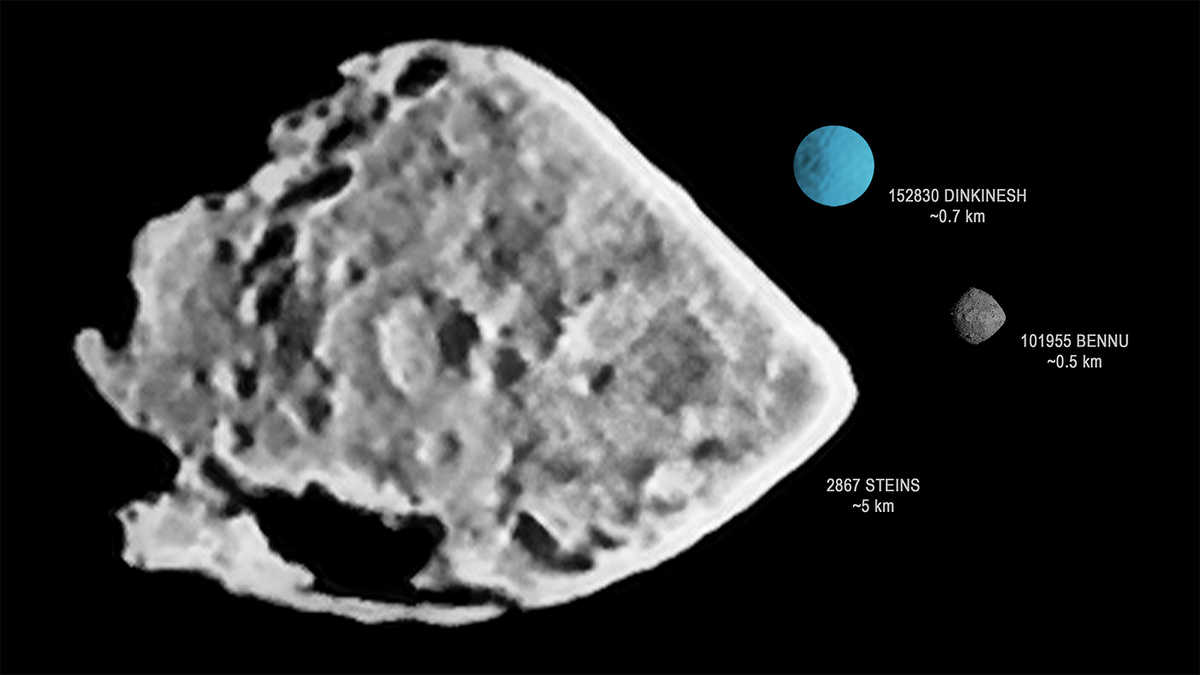
Courtesy of NASA Goddard montage/Image of Steins: ESA/OSIRIS Team/Image of BENNU: NASA Goddard/University of Arizona
The Lucy team compared the size of Dinkinesh (shown in blue in the artist’s concept) to the main belt asteroid Steins and the near-Earth asteroid Bennu. Steins is currently the smallest, independently orbiting main belt asteroid that has been well imaged by a spacecraft (ESA Rosetta). NASA’s Osiris-REx spacecraft recently explored the near-Earth asteroid Bennu. The tiny main belt asteroid Dinkinesh will serve as a link between these two populations.
Dinkinesh is the Ethiopian name for the human-ancestor fossil also known as Lucy, which was discovered in that country. Dinkinesh means “you are marvelous” in Amharic. The mission was named for Lucy because, just as that fossil revolutionized our understanding of human evolution, this mission will likely revolutionize our understanding of the origin and evolution of our solar system.
“This is really a tiny little asteroid,” said Lucy Principal Investigator Dr. Hal Levison, of SwRI’s Solar System Science and Exploration Division located in its offsite office in Boulder, Colorado. “Some of the team affectionately refer to it as ‘Dinky.’ But, for a small asteroid, we expect it to be a big help for the Lucy mission.”
The Lucy mission was already on course to break records by its planned visit of nine asteroids during its 12-year mission to tour the Jupiter Trojan asteroids, which orbit the Sun at the same distance as Jupiter. Originally, Lucy was not expected to get a close-up view of any asteroids until 2025, when it will fly by the main belt asteroid (52246) Donaldjohanson, named for the anthropologist who discovered the Lucy fossil.
The Lucy team realized that, with a small maneuver, the spacecraft could get a close look at this asteroid. On January 24, 2023, the team officially added the asteroid flyby to evaluate the spacecraft’s pioneering terminal tracking system. The new system solves a longstanding problem for flyby missions: During a spacecraft’s approach to a target, it is quite difficult to determine exactly how far the spacecraft is from the asteroid and exactly which way to point the cameras.
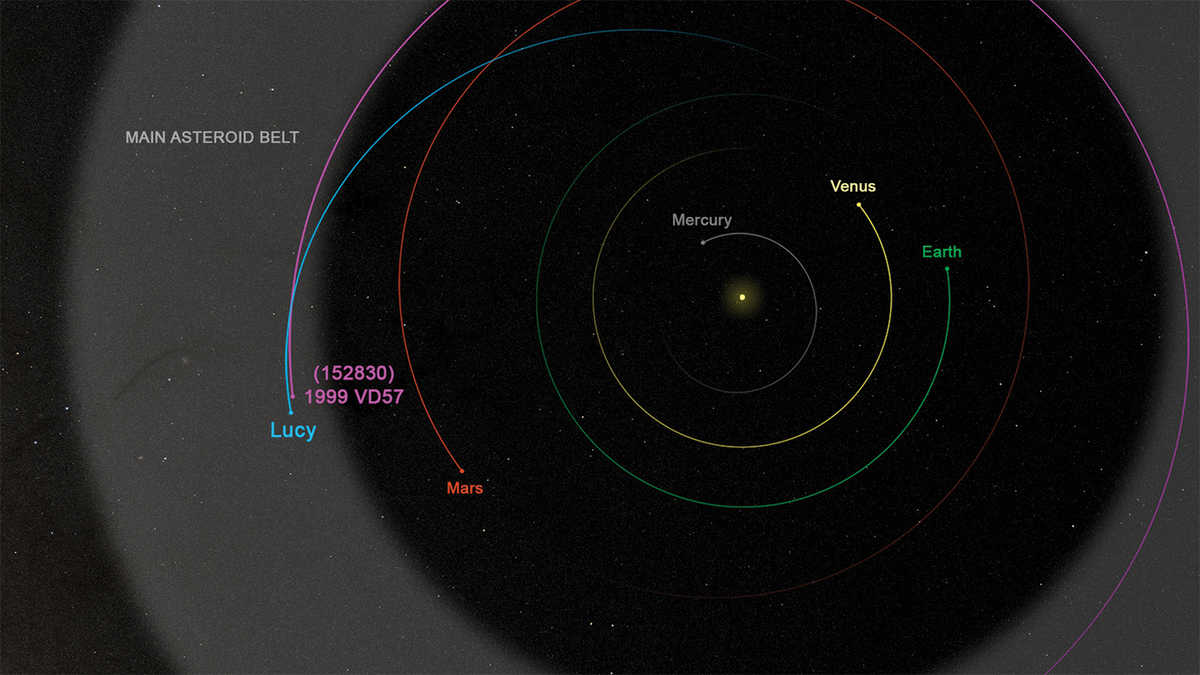
Courtesy of NASA Goddard montage/Image of Steins: ESA/OSIRIS Team/Image of BENNU: NASA Goddard/University of Arizona
As NASA’s Lucy spacecraft travels through the inner edge of the main asteroid belt in the fall of 2023, the spacecraft will fly by the small asteroid recently named Dinkinesh. This graphic shows a top-down view of the solar system indicating the spacecraft’s trajectory shortly before the November 1 encounter.
“In the past, most flyby missions have accounted for this uncertainty by taking a lot of images of the regions where the asteroid might be, which is inefficient and produces lots of images of blank space,” Levison said. “Lucy will be the first flyby mission to employ an innovative and complex system to automatically track the asteroid during the encounter. The novel terminal tracking system will allow the spacecraft to take many more images of the target.”
Dinkinesh provides an excellent opportunity to validate this new procedure. The geometry of this encounter — particularly the angle that the spacecraft approaches the asteroid relative to the Earth and Sun — is very similar to the planned Trojan asteroid encounters. This flyby allows the team to carry out a dress rehearsal under similar conditions well in advance of the spacecraft’s main scientific objectives, the flybys of the never-before-explored Trojan asteroids.
“At closest approach, if all goes smoothly, we expect Dinkinesh to be 100s of pixels across as seen from Lucy’s sharpest imager,” says Dr. Simone Marchi, Lucy deputy principal investigator, also from SwRI. “While we won’t be able to see all the details of the surface, even the general shape may indicate whether near-Earth asteroids — which originate in the main belt — change significantly once they enter near-Earth space.
Web-Like Structures in the Sun's Middle Corona
Researchers from SwRI, NASA and the Max Planck Institute for Solar System Research have discovered how web-like plasma structures in the Sun’s middle corona influence the structure of the solar wind. In a study published in Nature Astronomy, the researchers describe an innovative new observation method, imaging the middle corona in ultraviolet (UV) wavelength. The findings could lead to a better understanding of the solar wind’s origins and its interactions with the rest of the solar system.
The solar wind is a stream of energized, charged particles, flowing outward from the Sun, and creating our heliosphere, a protective bubble around our solar system.
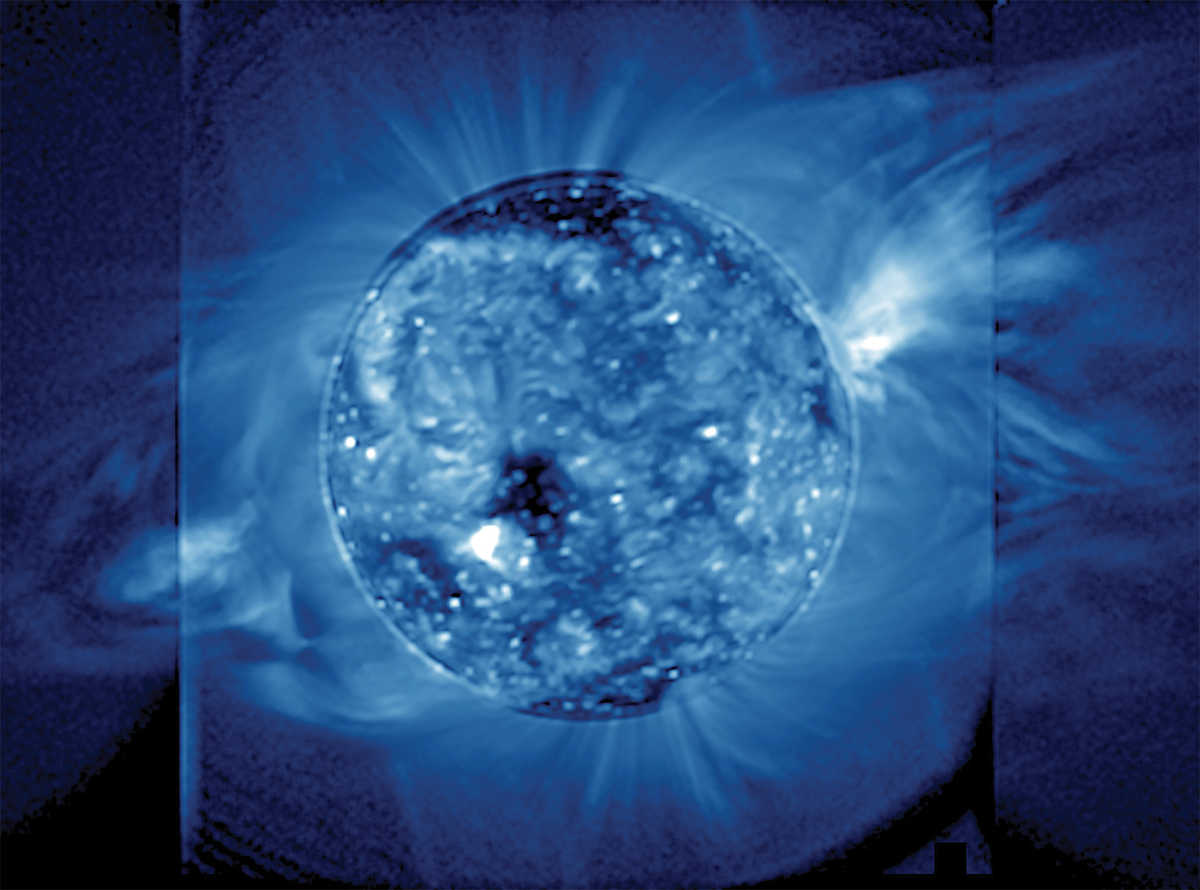
Courtesy of SwRI/NOAA
“As the solar wind evolves, it can drive space weather and affect things like power grids, satellites and astronauts,” said SwRI Principal Scientist Dr. Dan Seaton, one of the authors of the study. “The origins of the solar wind itself and its structure remain somewhat mysterious.”
Since 1995, the U.S. National Oceanic and Atmospheric Administration (NOAA) has monitored space weather that could affect the Earth using the Large Angle and Spectrometric Coronagraph (LASCO) aboard the Solar and Heliospheric Observatory spacecraft. However, LASCO has an observational gap that obscures views of the middle solar corona, where the solar wind originates.
Seaton suggested pointing the Solar Ultraviolet Imager on NOAA’s Geostationary Operational Environmental Satellites obliquely, from both sides of the Sun, for a month. The data show elongated, web-like plasma structures in the Sun’s middle corona. Interactions within these structures release stored magnetic energy propelling particles into space.
“We had no idea if it would work or what we would see,” he said. “The results were very exciting. For the first time, we have high-quality observations that completely unite our observations of the Sun and the heliosphere as a single system.”
These observations will inform additional discoveries from missions like PUNCH (Polarimeter to UNify the Corona and Heliosphere), an SwRI-led NASA mission that will image how the Sun’s outer corona becomes the solar wind.
JIP Aims to Improve Sour Well Models
SwRI has launched the first phase of the In Situ Measurement of Hydrogen Sulfide to Validate Thermodynamic Calculations Joint Industry Program (JIP), which aims to more accurately model caustic environments in sour wells and better define the materials needed to withstand those harsh operating conditions. OLI Systems Inc. is collaborating on the sour well JIP.

Sour wells produce gases mixed with hydrogen sulfide (H2S). Deeper sour wells combine higher pressures and temperatures, creating particularly challenging environments. Currently, the industry uses expensive corrosion-resistant alloys during exploration and production. The alloys are qualified using both documented field experience and laboratory testing, but a recent review of the chemistry of sour wells suggests that these environmental test conditions are harsher than required. The industry could save millions of dollars on the materials used in sour well conditions.
“The aim of SwRI’s JIP is to create a new, more accurate model of the chemical conditions in sour wells,” said SwRI Senior Research Engineer Florent Bocher, who is leading the project. “We will learn more about the chemistry of these wells at high pressures and temperatures. To accomplish this, we will use existing equipment at SwRI to measure hydrogen sulfide in the gas and liquid phases at the pressures and temperatures that exist in those wells.”
During the JIP’s first year, engineers will generate an experimental matrix at the intersection between the industry needs, published data and model limitations and will validate in situ analytical techniques. In the second phase, engineers will measure in situ H2S over the experimental matrix. These measurements will be input into the modeling software to offer a more accurate and reliable simulation of sour well conditions and ultimately better define what materials are necessary and lower the cost of components.
Developing a Heavy-Duty Hydrogen Combustion Vehicle
SwRI has launched a joint industry program (JIP) to retrofit a Class 8 heavy-duty vehicle with a hydrogen engine to demonstrate the potential of hydrogen-powered engines using current technology.

SwRI launched an industry program to develop and build a unique hydrogen combustion engine demonstration vehicle. The joint industry project will use current technology to create a “zero-emissions” heavy-duty vehicle.
“The new initiative will create a working demonstration of current technology’s capabilities for decarbonization and achieving zero or near-zero emissions of both greenhouse gases and criteria pollutants,” said Dr. Terry Alger, executive director of SwRI’s Sustainable Energy and Mobility Directorate. “We believe that sustainably sourced hydrogen in an internal combustion engine (ICE), when used in combination with other decarbonization and clean emissions technologies, can provide low emissions that are competitive with both battery and fuel-cell electric vehicles.”
The SwRI-managed Hydrogen Internal Combustion Engine (H2-ICE) JIP aims to design and build a working H2-ICE vehicle. The vehicle will have an on-board emissions measurement system to validate near-zero carbon dioxide emissions and ultra-low emissions of nitrogen oxides (NOx) and particulate matter pollution production.
JIP members will contribute vehicle components. SwRI will integrate its best-in-class, ultra-low NOx aftertreatment technology, originally developed to help diesel engines meet California Air Resources Board (CARB) regulatory standards for target date 2027. CARB is charged with combatting air pollution in the country’s most populous state.
SwRI has decades of experience working with regulatory agencies, vehicle manufacturers and suppliers to address emissions challenges. Once completed, the H2-ICE vehicle will be tested to ensure it aligns with standards in the Phase III Greenhouse Gas Rules to be set by the U.S. Environmental Protection Agency (EPA) in 2023 and the 2027 CARB regulations for heavy-duty vehicles, as well as the anticipated EURO VII rules for heavy-duty vehicles.
“Battery electric and fuel cell-powered vehicles tend to dominate the conversations surrounding zero-emission vehicle technologies,” Alger said. “Through this program, we are working with industry to ensure that current technology, like internal combustion engines, is not left out of the decarbonization conversations by federal and state regulators. We have a significant number of industry members and donors sharing hardware to show the potential of H2-ICE technology.”
Once completed, the H2-ICE vehicle will make appearances at trade shows and ride-and-drive events across the country to demonstrate the technology’s potential as a realistic pathway for decarbonization. The targeted vehicle completion date is December 2023 with vehicle demonstrations planned throughout 2024.
The H2-ICE JIP kick-off meeting was in November 2022. SwRI received majority approval from a project advisory committee to manage H2-ICE. Arising intellectual property will be owned by SwRI and shared with funding members.
SwRI Delivers Next-Generation Space Instrument
SwRI delivered a groundbreaking new mass spectrometer for integration onto NASA’s Europa Clipper spacecraft. Scheduled to launch in 2024 and arrive in the Jovian system by 2030, the spacecraft will conduct a detailed science investigation of the moon Europa and study whether it could harbor conditions suitable for life.
The MAss Spectrometer for Planetary EXploration (MASPEX) instrument is one of nine science instruments in the mission payload, which also includes Europa-UVS, an SwRI-developed Ultraviolet Spectrograph, the latest in a series of UV instruments. MASPEX will analyze the gases near Europa to understand the chemistry of Europa’s surface, atmosphere and suspected subsurface ocean. MASPEX will study how Jupiter’s radiation alters Europa’s surface compounds and how its icy surface and subsurface ocean exchange material.
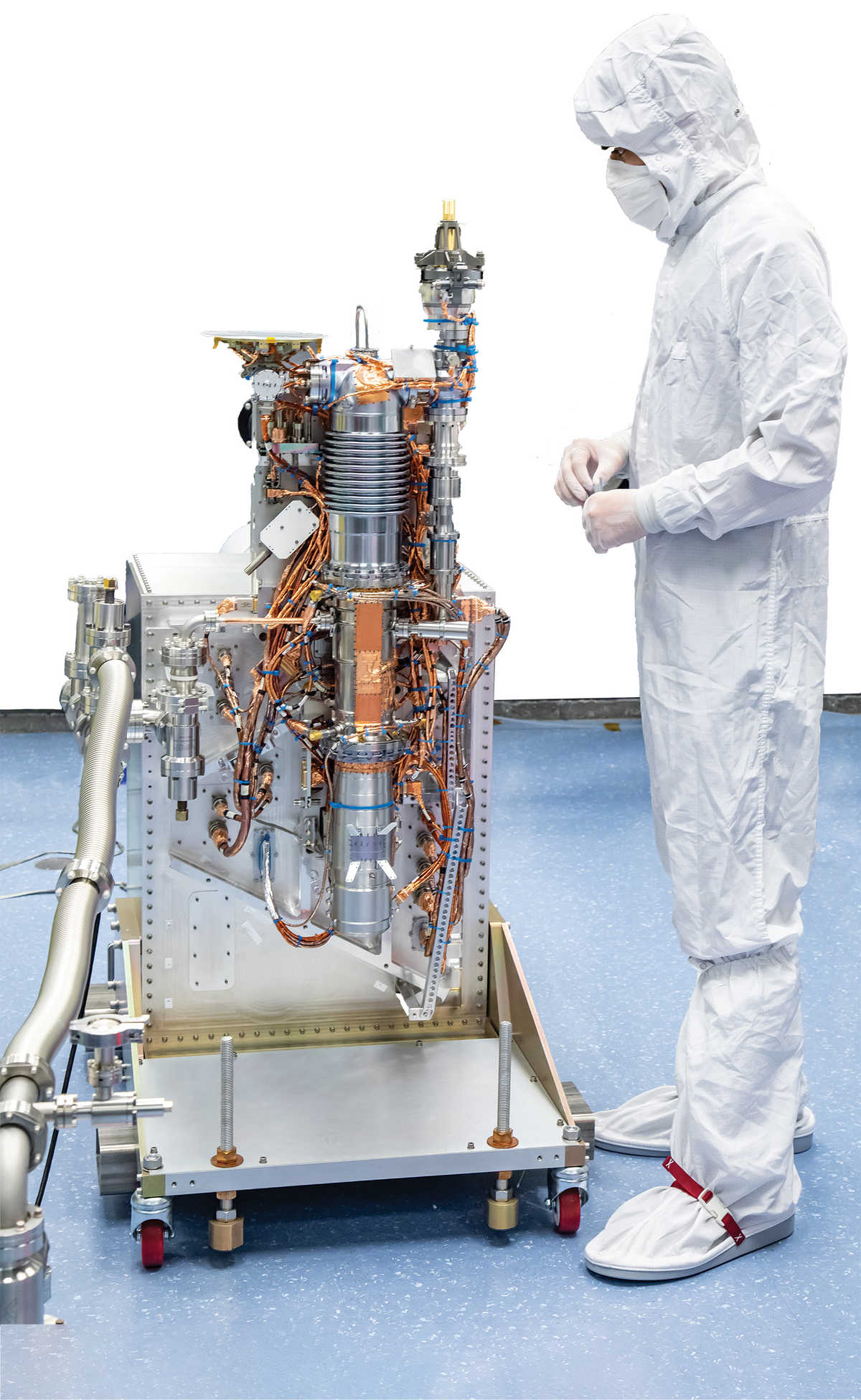
The Space Science and Space Systems Divisions developed a groundbreaking new mass spectrometer for NASA’s Europa Clipper mission to study the potential habitability of Jupiter’s moon Europa. The MAss Spectrometer for Planetary EXploration (MASPEX) instrument has a mass resolution hundreds of times finer than anything that has flown to space before.
“MASPEX has a mass resolution hundreds of times finer than anything that has flown to space before,” said SwRI Senior Vice President Dr. Jim Burch, who serves as MASPEX principal investigator. Burch leads the Institute’s Space Sector, with three divisions devoted to space science, solar system science and space systems. “SwRI has used internal funding and NASA resources to develop an instrument able to differentiate between molecules with almost identical masses based on the energy binding the atoms. It also differentiates isotopes — atoms with equal numbers of protons but a different number of neutrons. These capabilities are critical to revealing the secrets of Europa.”
Once it arrives, Europa Clipper will orbit Jupiter and perform repeated close flybys of the icy moon. MASPEX works by taking in gas molecules lofted from the surface of Europa and converting them into charged particles called ions. It bounces the ions (atoms and molecules missing an electron) up to 400 times back and forth within the instrument. By timing their transit through the instrument, MASPEX measures the mass of these ions, which reveals each molecule’s identity, which in turn will help determine whether Europa is habitable.
“We hope to identify and fly through plumes and other sources of gas venting from cracks in Europa’s icy surface,” said SwRI’s Dr. Christopher Glein, MASPEX co-investigator and a planetary geochemist. “We know microbes on Earth exploit any molecule that can serve as a food source. MASPEX is going to help Europa Clipper determine whether there is anything for microbes to eat, such as organic molecules that might be sourced from hydrothermal vents at the bottom of a deep ocean. The data from this exciting mission will give us a much richer perspective on the habitability of Europa.”
Detecting Pipeline Corrosion to Prevent Leaks
SwRI has created next-generation ultrasonic guided wave technology to detect anomalies in pipes, enabling users to prevent leaks before they start. The transducer uses SwRI-developed Magnetostrictive Sensor® (MsS®) technology.
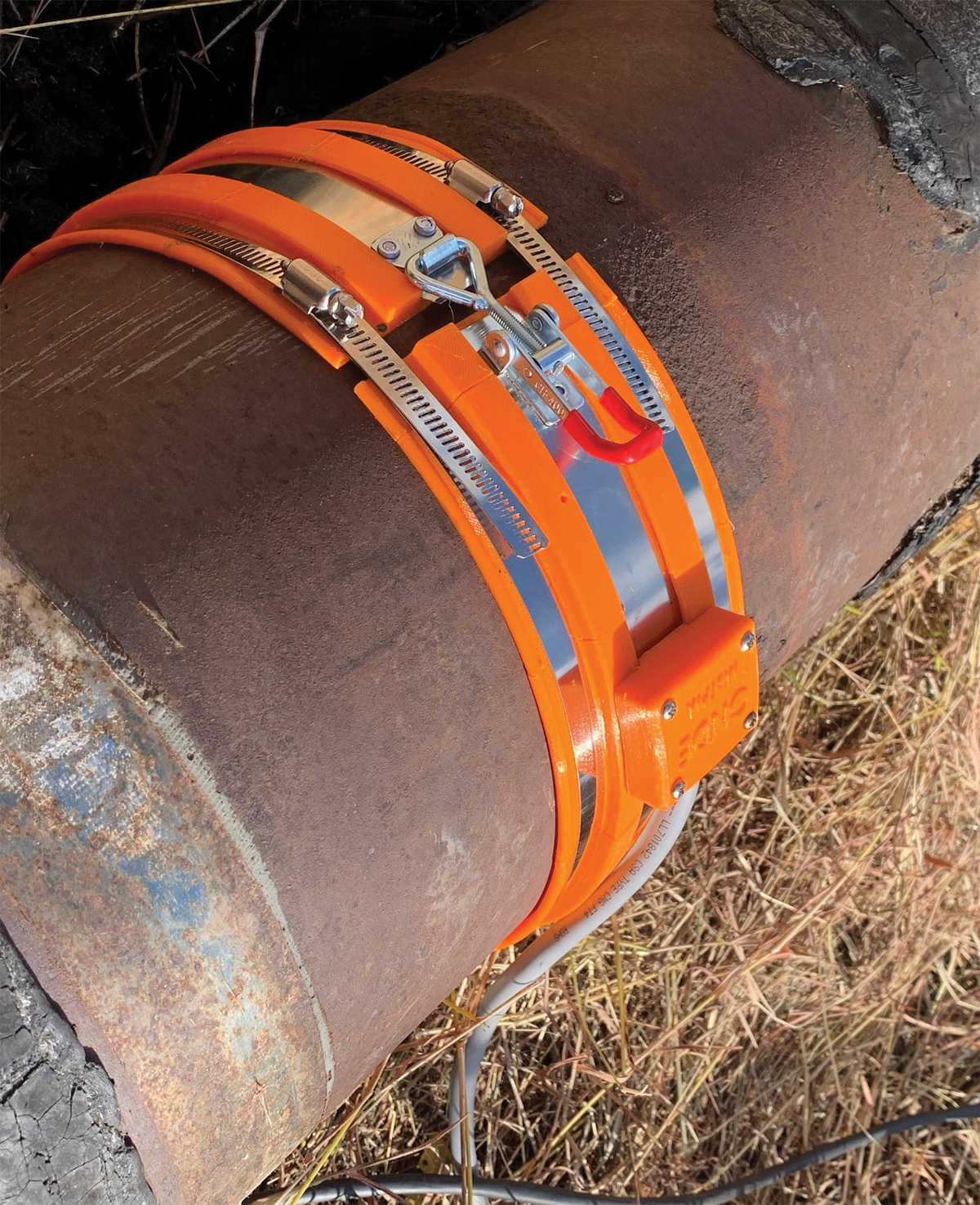
“Pipeline corrosion resulting in leaks is very common,” said SwRI Staff Engineer Dr. Sergey Vinogradov, who led the development. “We’ve developed a technology that can consistently monitor the pipe’s condition, hopefully preventing leaks from happening.”
The Magnetostrictive Transducer (MsT) Collar, originally developed by SwRI in 2002, now has a lower profile allowing its use on pipes in tight spaces. In custom configurations, it can withstand heat up to 400 degrees Fahrenheit. The new, segmented MsT design also features eight sensors to more accurately identify where pipe corrosion is occurring.
The MsT Collar propagates waves along an elongated structure, guided by its boundaries, to travel long distances with little loss of energy. Sometimes a single sensor can inspect hundreds of meters, though obstacles such as couplings would require additional sensors.
“The eight sensors in the transducer collect the full range of signals,” Vinogradov said. “Algorithms combine this information to better detect and locate the anomaly both axially and circumferentially. Corrosion growth can also be monitored by examining data sets acquired over time.”
The MsS system can send data to a remote terminal via a wireless transmitter unit or through a wired connection. It is designed primarily for oil and gas transmission pipelines to prevent costly and damaging leaks before they begin. However, the versatile technology supports other industrial piping systems.
More Evidence for a Stealth Ocean World
When an SwRI scientist discovered surprising evidence that Saturn’s smallest, innermost moon could generate the right amount of heat to support a liquid internal ocean, colleagues began studying Mimas’ surface to understand how its interior may have evolved. Numerical simulations of the moon’s Herschel impact basin, the most striking feature on its heavily cratered surface, determined that the basin’s structure and the lack of tectonics on Mimas are compatible with a thinning ice shell and geologically young ocean.
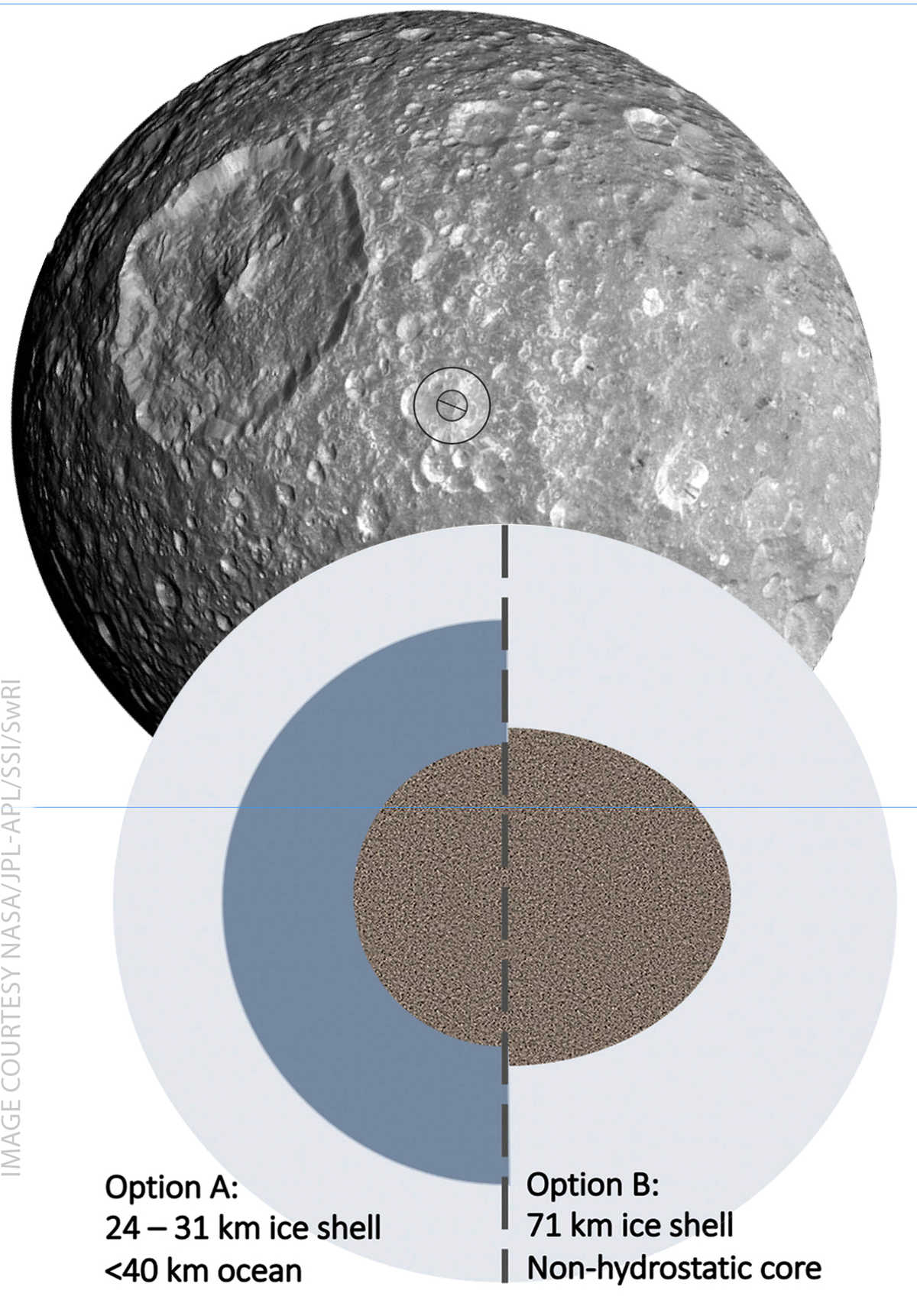
Courtesy of NASA/JPL-APL/SSI/SwRI
Mimas’ heavily cratered surface suggests a cold history, but its librations rule out a homogeneous interior. Mimas must have a rocky interior and outer hydrosphere, which could include a liquid ocean (A) or be fully frozen with an irregularly shaped core (B). An ocean provides a better fit to the phase of the libration but is difficult to reconcile with Mimas’ geology.
“In the waning days of NASA’s Cassini mission to Saturn, the spacecraft identified a curious libration, or oscillation, in Mimas’ rotation, which often points to a geologically active body able to support an internal ocean,” said SwRI’s Dr. Alyssa Rhoden, a specialist in the geophysics of icy satellites, particularly those containing oceans, and co-author of a new Geophysical Research Letters paper on the subject. “Mimas seemed like an unlikely candidate. Its icy, heavily cratered surface marked by one giant impact crater makes the small moon look like the Death Star from Star Wars. If Mimas has an ocean, it represents a new class of small, ‘stealth’ ocean worlds with surfaces that do not betray the ocean’s existence.”
Rhoden worked with Purdue graduate student Adeene Denton to better understand how a heavily cratered moon like Mimas could possess an internal ocean. Denton modeled the formation of the Hershel impact basin using iSALE-2D simulation software. The results imply that a present-day ocean within Mimas must have been warming and expanding since the basin formed.
“Although our results support a present-day ocean within Mimas, it is challenging to reconcile the moon’s orbital and geologic characteristics with our current understanding of its thermal-orbital evolution,” Rhoden said. “Evaluating Mimas’ status as an ocean moon would help us better understand Saturn’s rings and mid-sized moons as well as the prevalence of potentially habitable ocean moons, particularly at Uranus. Mimas is a compelling target for continued investigation.”
Dark Secrets from the Frozen Heart of an Interstellar Cloud
An international team including SwRI, Leiden University and NASA used observations from the James Webb Space Telescope (JWST) to achieve the darkest-ever view of a dense interstellar cloud. These observations revealed the composition of a virtual treasure chest of primordial ices, providing new insights into the chemical processes of one of the coldest, darkest places in the universe as well as the origins of the molecules that make up planetary atmospheres.
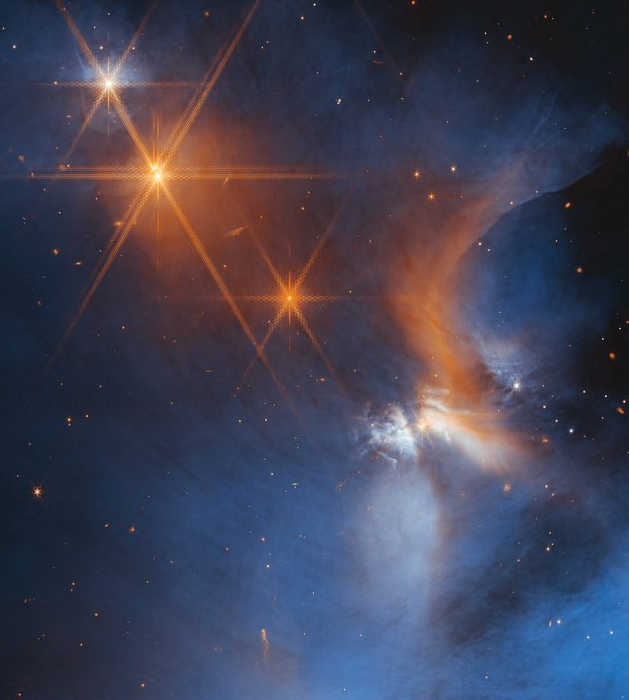
Courtesy of Courtesy of NASA/ESA/CSA/M. ZAMANI (ESA/WEBB)/M. K. MCCLURE (LEIDEN OBSERVATORY)/F. SUN (STEWARD OBSERVATORY)/Z. SMITH (OPEN UNIVERSITY)/ICE AGE ERS TEAM
NASA’s JWST has a 6.5-meter-wide mirror providing remarkable spatial resolution and sensitivity, optimized for infrared light. As a result, the telescope has been able to image the densest, darkest clouds in the universe for the first time.
“These observations provide new insights into the chemical processes in one of the coldest, darkest places in the universe to better understand the molecular origins of protoplanetary disks, planetary atmospheres and other solar system objects,” said SwRI Research Scientist Dr. Danna Qasim. “The ices we observed contain only 1% of the sulfur we’re expecting. The other 99% of that sulfur is locked up somewhere else. We need to figure out where to understand how sulfur will eventually be incorporated into the planets that may host life.”
In the study, Qasim and colleagues propose that the sulfur may be locked in reactive minerals like iron sulfide.
“Iron sulfide has been detected in the accretion disks of young stars and in samples returned from comets. It’s also the most common sulfide mineral in lunar rocks,” Qasim said. “If sulfur is locked up in these minerals, that could explain the low levels of sulfur in interstellar ices, which has implications for where sulfur is stored in our solar system. For example, sulfur in the atmosphere of Venus may have originated from interstellar-inherited minerals.”
Novel Microscopy Method Maps Damage to Sand Screens
SwRI has created a more effective method to evaluate changes in sand control screens used in oil and gas production wells. Using accelerated life erosion testing, the new method pinpoints the location of erosion and can be used to evaluate other equipment in harsh environments.
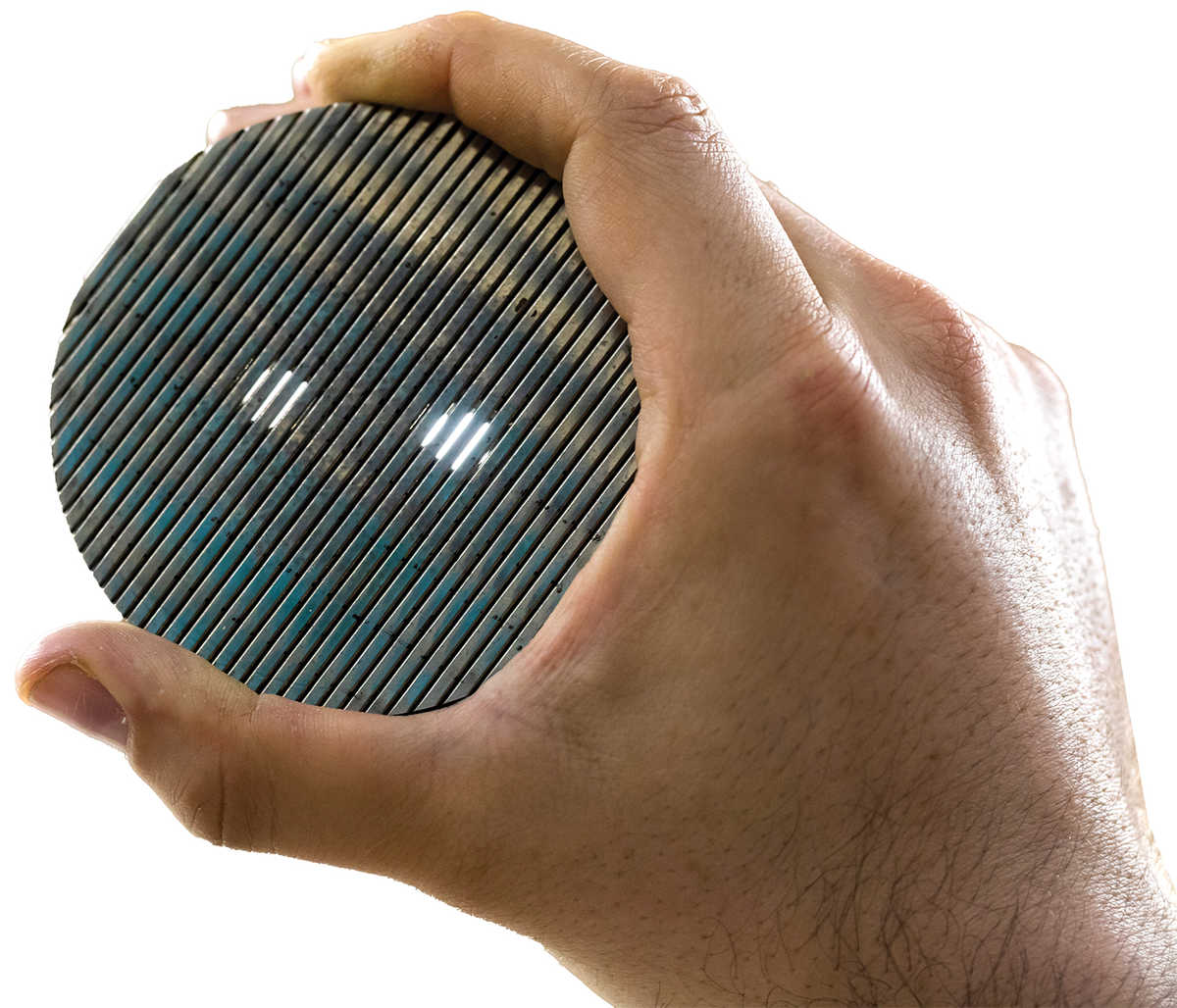
In oil and gas production wells, sand screens keep formation and fracturing sand in the reservoir while allowing fluids to be produced. Fine sands, smaller than the screen gaps, periodically pass through the screens, causing erosion that can eventually lead to screen failure. Sand produced with oil and gas in a well can erode the equipment between the reservoir and the surface, causing costly production halts to repair or replace damaged components.
“Measuring erosion in sand screens is challenging. Current methods use a single point value to describe erosion that differs across various regions,” said Jessica Brysch, an assistant program manager in SwRI’s Fluids Engineering Department. “These methods identify only the largest gap associated with erosive flow through a sand screen. Our method identifies each gap.”
Using internal research funding, SwRI developed a graphical approach to express sand screen erosion, providing a more complete picture of the damage. The method examines both the screen and base pipe layers.
“Using microscopy, we have developed a novel visual technique, providing a spatial understanding of where erosion is occurring,” said Dr. Luis Gutierrez, a research engineer in SwRI’s Fluids Engineering Department. “Our method maps the magnitude and location of erosion experienced in both the screen and base pipe layer.”
SwRI has extended the visualization methods to other types of equipment to quantify erosion in harsh environments. The technique can also help predict component life under specific well conditions, rather than waiting for equipment to fail.
Automated Leak Detection Systems for the Rail Industry
SwRI has developed a proof-of-concept system to autonomously detect compressed air leaks on trains and relay the location of the leaks to maintenance personnel for repair. The automated system could reduce the time, costs and labor needed to find and repair air leaks and ultimately lower the locomotive industry’s overall fuel consumption and emissions.
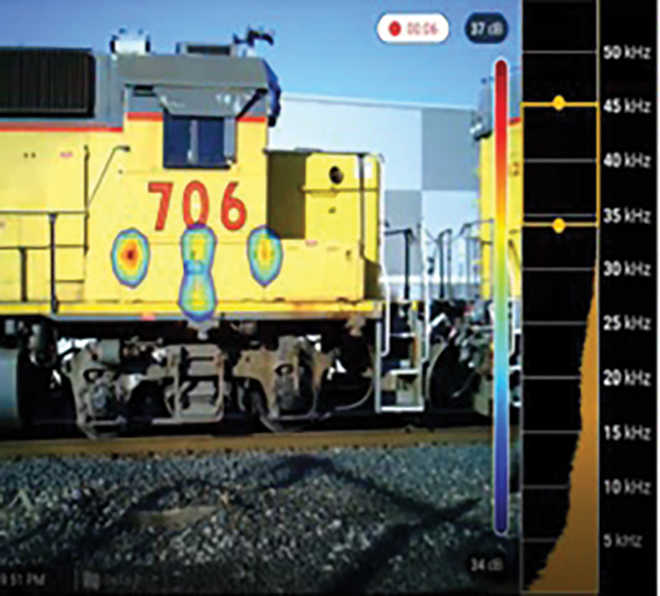
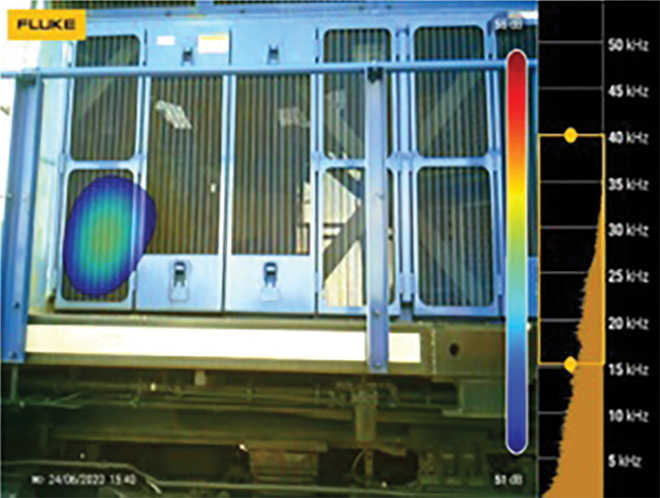
The team tested the leak detection proof-of-concept system at SwRI’s Locomotive Technology Center in San Antonio.
Trains use compressed air for a variety of functions, including air brakes, valve actuation, radiator shutters, horns and bells. Each year, the rail industry loses an estimated 2-3% in vehicle efficiency due to air leaks at various points throughout trains. These leaks can also affect train operability and safety.
“Air leaks significantly increase fuel consumption and reduce the effectiveness of a locomotive’s automatic engine stop-start systems, causing it to burn more fuel and reducing the lifespan of parts such as starters, air compressors and batteries,” said SwRI Lead Engineer Christopher Stoos. “An automated air leak detection system could save millions of gallons of fuel and reduce carbon dioxide, oxides of nitrogen and particulate matter emissions.”
Currently, railroad employees manually search for air leaks, venturing on, under or between railway cars to listen or feel for leaks. Because this inefficient, time-consuming practice introduces unnecessary risk to maintenance staff, the Federal Railroad Administration has established acceptable air leak rates for trains.
To significantly reduce these leaks, SwRI has created a system that uses audio detection technology, visual cameras and machine learning to autonomously detect, identify and report air leaks, even on moving trains. During testing, the prototype system successfully detected a range of air leaks at various locations with a false positive rate of only 0.03%. The system detected 11 out of every 13 leaks on a moving train. Once the system identifies an air leak, it electronically shares an alert and an image of the site with maintenance for repairs.
The system — funded by the Transportation Research Board’s (TRB) Rail Safety IDEA program and led by Stoos, Senior Research Engineer Heath Spidle and Research Engineer Jake A. Janssen — needs additional field development and testing.
Occultations of Saturn's Rings
SwRI scientists have compiled 41 solar occultation observations of Saturn’s rings from the Cassini mission. The compilation, published recently in the scientific journal Icarus, will inform future investigations of the particle size, distribution and composition of Saturn’s rings, key elements to understanding their formation and evolution.
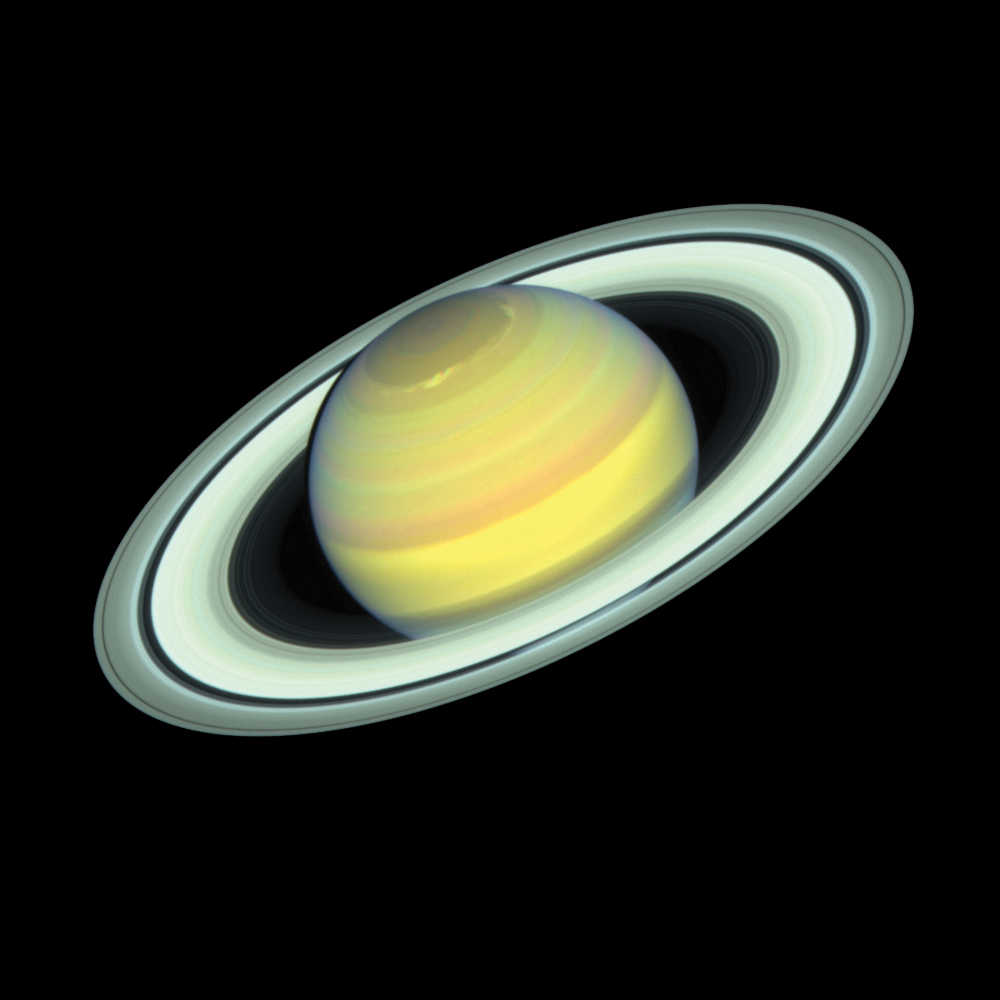
Courtesy of NASA/JPL-CALTECH/SSI/CORNELL
“For nearly two decades, NASA’s Cassini spacecraft shared the wonders of Saturn and its family of icy moons and signature rings, but we still don’t definitively know the origins of the ring system,” said Dr. Stephanie Jarmak, a researcher in the SwRI Space Science Division. “Evidence indicates that the rings are relatively young and could have formed from the destruction of an icy satellite or a comet. However, to support any one origin theory, we need to have a good idea of the size of particles making up the rings.”
Cassini’s Ultraviolet Imaging Spectrograph (UVIS) was uniquely sensitive to some of the smallest ring particles, particularly with the observations it made in the extreme ultraviolet wavelength.
To determine the size of the ring particles, UVIS observed them when the instrument was pointed at the Sun, looking through the rings in what is known as a solar occultation. Ring particles partially blocked the path of the light, providing a direct measurement of the optical depth, a key parameter for determining the size and composition of the ring particles.
“Given the wavelength of the light coming from the Sun, these observations gave us insight into the smallest particle sizes with Saturn’s rings,” Jarmak said. “UVIS can detect dust particles at the micron level, helping us understand the origin, collisional activity and destruction of the ring particles within the system.”
The team also studied variations in the optical depth of occultation observations, which can be used to understand major differences in the structure and density of Saturn’s rings
Magnetic Reconnection Between Ganymede, Jupiter
In June 2021, NASA’s Juno spacecraft flew close to Ganymede, Jupiter’s largest moon, observing evidence of magnetic reconnection.
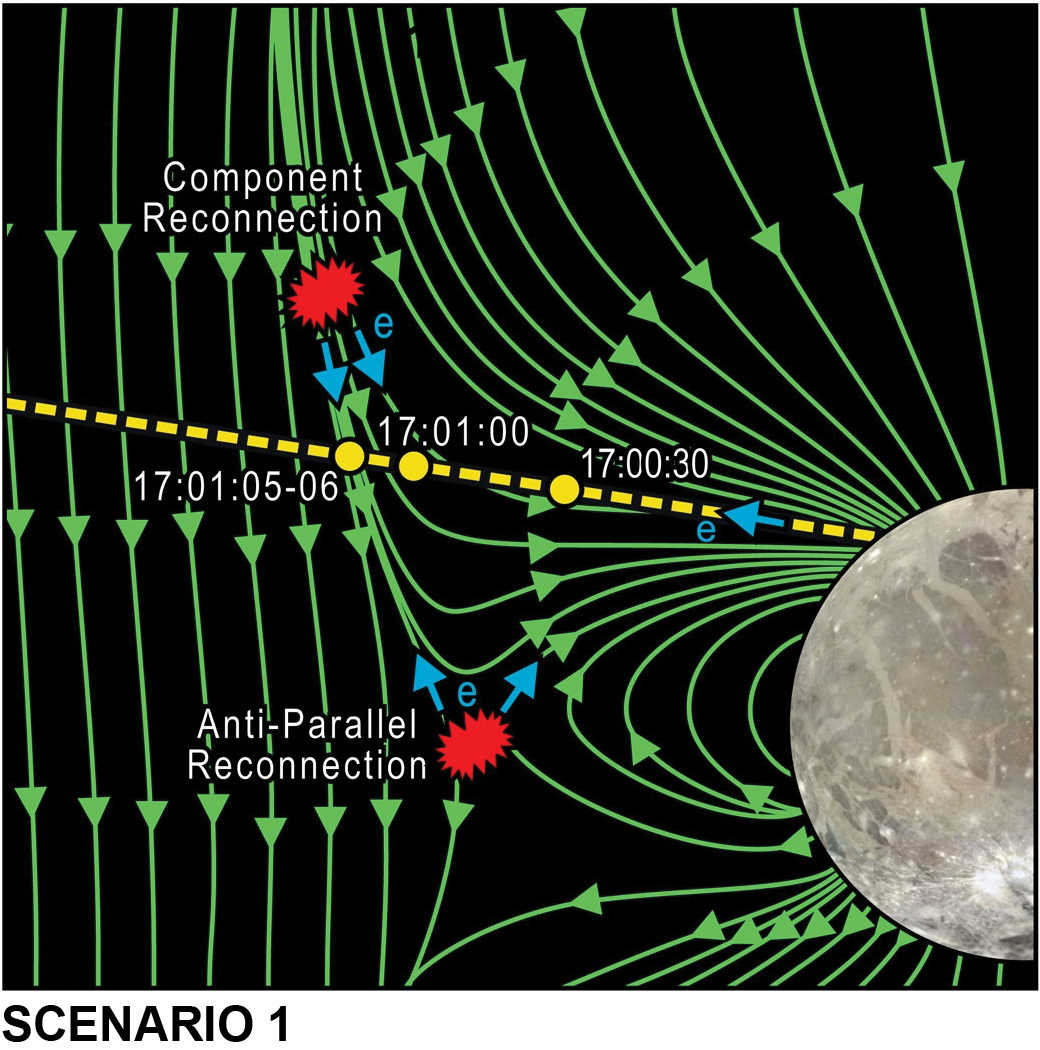
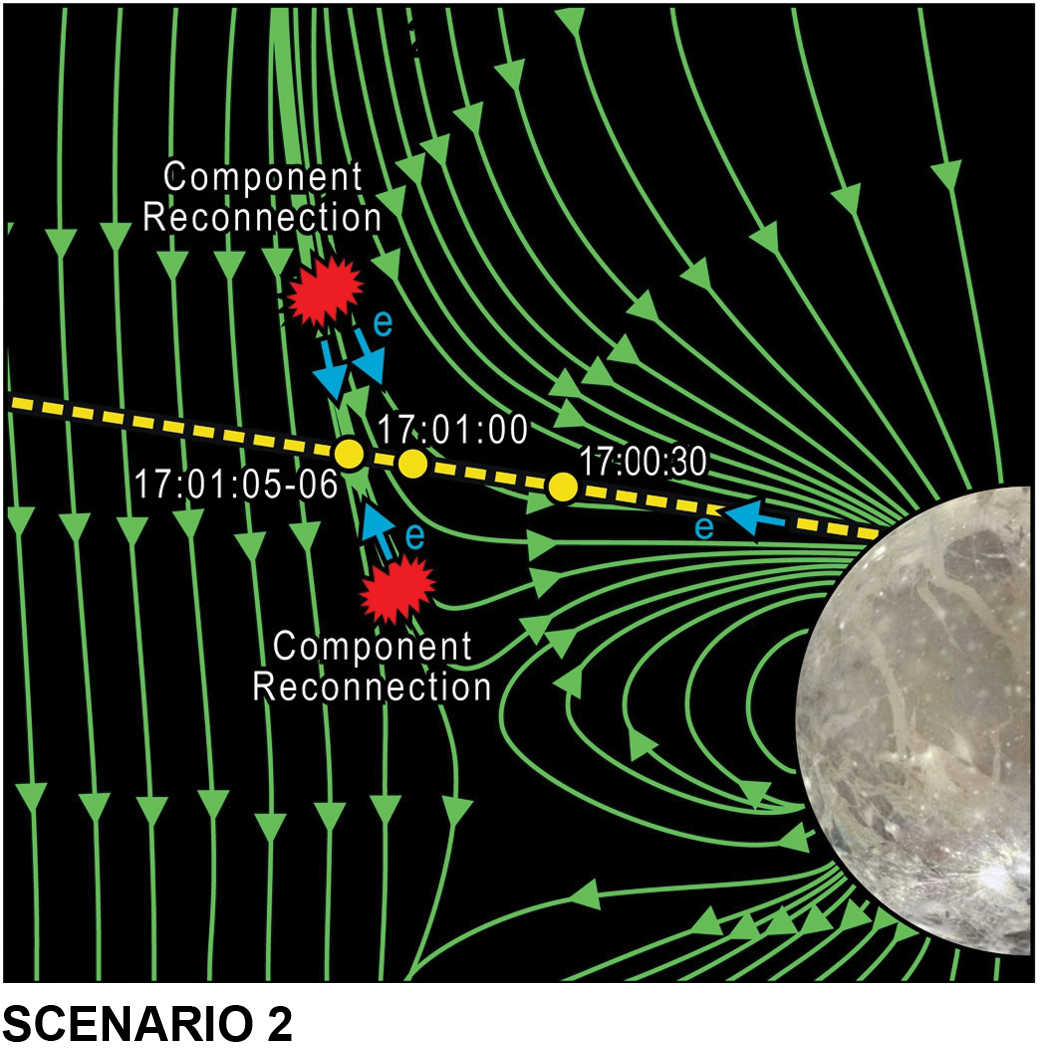
Courtesy of SwRI/JIA ET AL (2008)
An SwRI-led team used Juno spacecraft data to characterize the magnetic topology and electron flow direction for two different reconnection scenarios at the magnetopause of Ganymede, Jupiter’s largest moon. The yellow dashed line indicates Juno’s trajectory.
An SwRI-led team used Juno data to examine the electron and ion particles and magnetic fields as the magnetic field lines of Jupiter and Ganymede merged, snapped and reoriented, heating and accelerating the charged particles in the region.
“Ganymede is the only moon in our solar system with its own magnetic field,” said Juno Principal Investigator Dr. Scott Bolton of SwRI. “The snapping and reconnecting of Ganymede’s magnetic field lines with Jupiter’s creates the magnetospheric fireworks.”
Magnetic reconnection is an explosive physical process that converts stored magnetic energy into kinetic energy and heat. Ganymede’s mini-magnetosphere interacts with Jupiter’s massive magnetosphere, in the magnetopause, the boundary between the two regions.
“We interpreted the presence of accelerated electrons traveling along the magnetic field at Ganymede’s magnetopause as evidence that magnetic reconnection was occurring there during the Juno flyby,” said Dr. Robert Ebert, lead author of a Geophysical Research Letters paper describing the findings. “These observations further support the notion that magnetic reconnection at Ganymede’s magnetopause can be a driver of dynamic processes in the local space environment around this moon of Jupiter.”
The SwRI-developed Jovian Auroral Distributions Experiment (JADE) aboard Juno observed enhanced electron fluxes, including accelerated, magnetic-field-aligned electrons. Reconnection as observed by Juno is thought to be related to the generation of Ganymede’s aurora.
“The accelerated electrons observed by JADE are similar to those observed by NASA’s Magnetospheric Multiscale (MSS) spacecraft during reconnection at the Earth’s magnetopause,” said Dr. Stephen Fuselier, a co-author of the paper. “That’s one of the exciting results from the Ganymede flyby: Despite the vast differences between Ganymede and Earth, we find commonality in the universal process of magnetic reconnection.”
Characterizing Transport Risks
SwRI has received a two-year, $650,000 contract from the U.S. Department of Transportation to study the transport risks associated with gases dissolved in hazardous liquids.

The federal government has well-defined quantitative criteria and regulations for distinguishing hazardous liquids and gases as well as their transport.
“The regulations related to the transportation of hazardous chemicals such as crude oil or gasoline are very different from those for transporting milk,” said Dr. Swanand Bhagwat, a fluids engineer leading the project. “However, the DOT lacks regulatory language to classify the liquids containing significant quantities of dissolved gases. Current regulations do not provide guidelines on how much gas can be dissolved in liquid without changing the hazard classification of the fluid.”
The regulatory gap makes it difficult to determine how to handle and ship the fluids as well as address compliance issues. The presence of gases such as methane and ethane in crude oil or dissolved air in fuels such as diesel and kerosene could increase the vapor pressure and the volatility of the liquids.
“To safely handle hazardous liquids containing dissolved gases, it is necessary to understand the acceptable thresholds,“ Bhagwat said. “It is difficult to estimate the risk of leaks associated with pressurization as well as fire or explosion hazards of ignitable mixtures in a shipping tank.”
Bhagwat is collaborating with SwRI’s Chemistry and Chemical Engineering Division to conduct experiments to ascertain the solubility of gases often found in hazardous liquids transported by rail. The team will then use computer modeling to characterize associated safety risks and hazards. Additional experiments will determine how the concentration of dissolved gas affects the hazardous properties of the liquid and identify how temperature changes and agitation associated with transport affect risks. Experiments will also assess risk associated with venting or leaking vapors of various gases exuded from liquids.
Icy Origins of Life
A new study led by SwRI’s Dr. Danna Qasim posits that interstellar cloud conditions may have played a significant role in the origin of key building blocks of life in the solar system.
“Carbonaceous chondrites, some of the oldest objects in the universe, are meteorites that are thought to have contributed to the origins of life,” Qasim said. “They contain several different molecules and organic substances, including amines and amino acids, which were critical building blocks for life on Earth. These substances are necessary to create proteins and muscle tissue.”
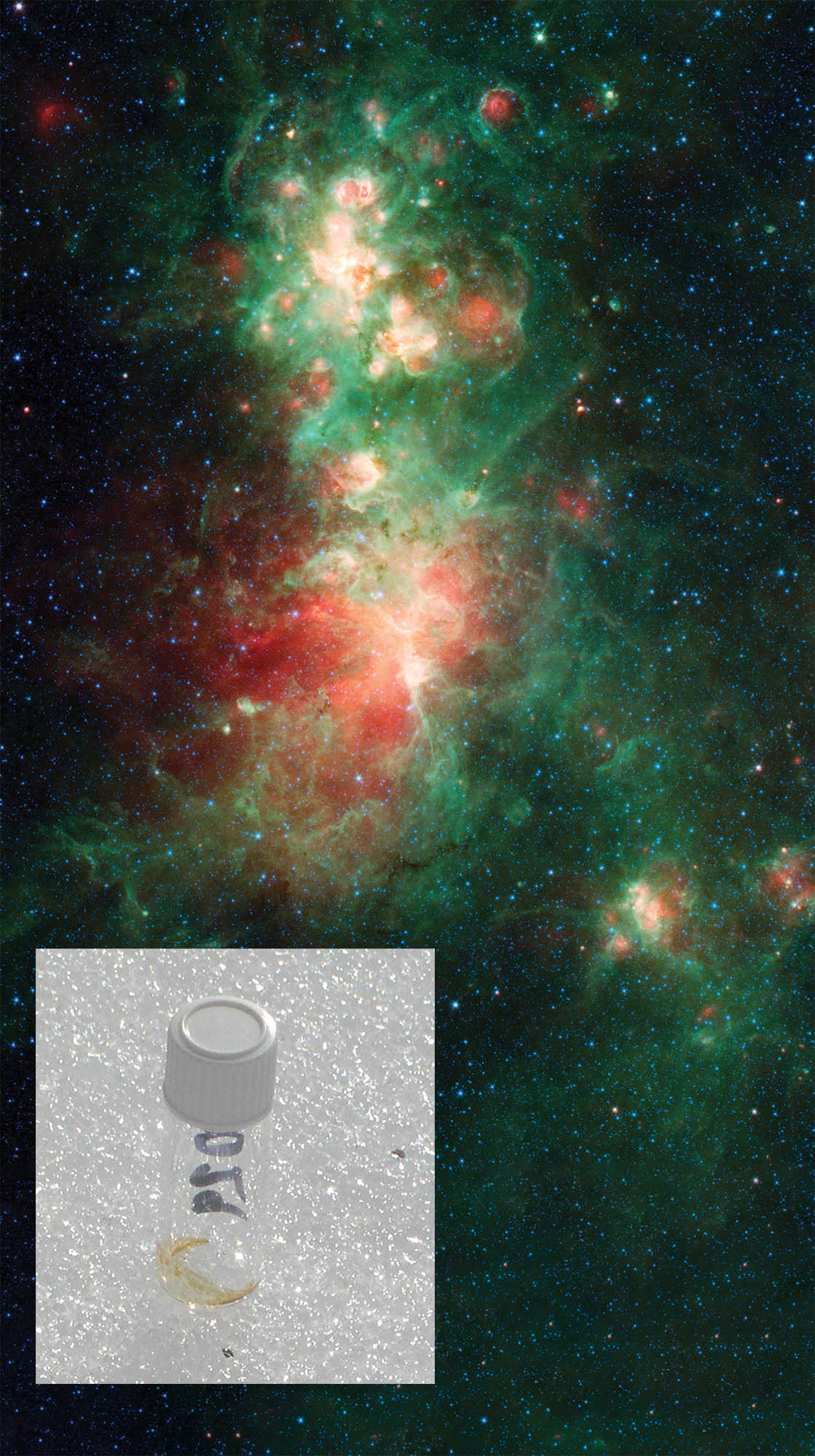
Courtesy of NASA/JPL-CalTech
Dr. Danna Qasim’s research conducted with NASA’s Goddard Space Flight Center indicates that interstellar cloud conditions may have played a significant role in the presence of key building blocks of life in the solar system. Her team simulated the formation of amines and amino acids as it would occur in the interstellar molecular cloud, forming an organic residue. She then processed the residue under asteroid-relevant conditions.
Most meteorites are fragments of asteroids that broke apart long ago in the asteroid belt, located between Mars and Jupiter. These rocky or metallic meteors orbit the Sun — sometimes for millions of years — before transiting the Earth’s atmosphere to impact its surface.
Scientists wonder how amino acids were assimilated into carbonaceous chondrites in the first place. Because most meteorites come from asteroids, scientists have attempted to reproduce amino acids by simulating asteroid conditions in a laboratory setting, a process called “aqueous alteration,” with limited success.
“However, the asteroid matter originated in the parental interstellar molecular cloud, which was rich in organics,” Qasim said. “The molecular cloud could have provided amino acids in parent asteroids, which passed them on to meteorites.”
Qasim simulated the creation of amines and amino acids in the laboratory to characterize the environmental conditions favoring formation.
“I created ices common in the cloud and irradiated them to simulate the impact of cosmic rays,” explained Qasim, who conducted the experiment while working at NASA’s Goddard Space Flight Center in Greenbelt, Maryland, between 2020 and 2022. “This caused the molecules to break up and recombine into larger molecules, which ultimately created an organic residue.”
Qasim then reprocessed the residue by recreating asteroid conditions through aqueous alteration and studied the substance, looking for amines and amino acids.
“No matter what kind of asteroid processing we did, the diversity of amines and amino acids from the interstellar ice experiments remained constant,” she said. “That tells us that interstellar cloud conditions are quite resilient to asteroid processing. These conditions could have influenced the distribution of amino acids we find in meteorites.”
However, the individual abundances of amino acids doubled, suggesting the asteroid processing influences the amount of amino acids present.
“Essentially we have to consider both the interstellar cloud conditions and processing by the asteroid to best interpret the distribution,” she said.
Asteroid samples from missions such as OSIRIS-REx and Hayabusa2 will help scientists better understand the role asteroid processes played vs. those the instellar cloud played in distributing the building blocks of life. Visit https://www.swri.org/podcast/ep52 to hear Qasim discuss her research on the Technology Today Podcast.

